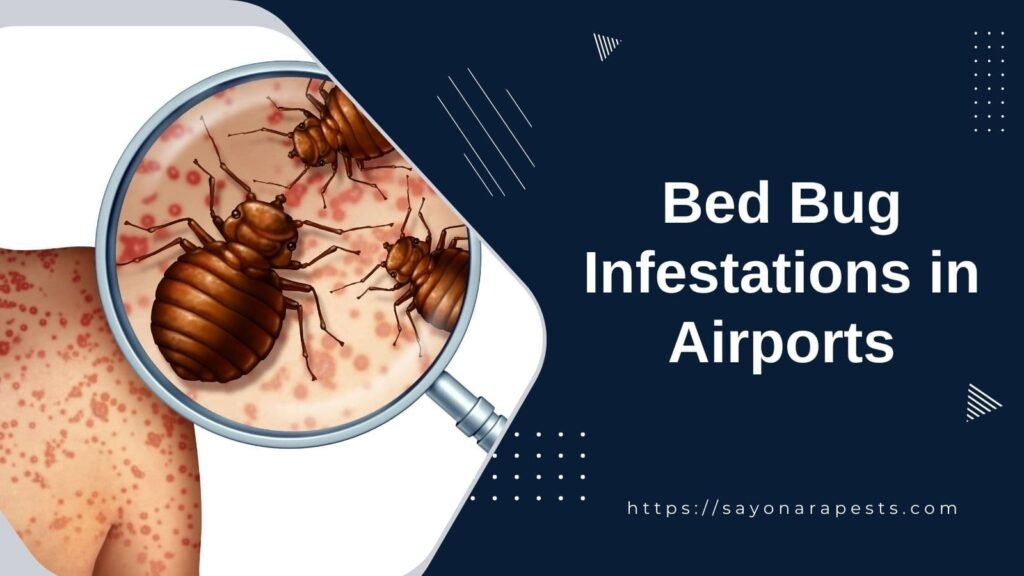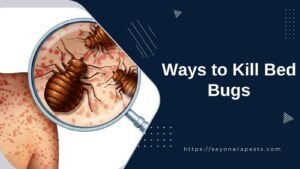Bed Bug Infestation Risks
The risk of encountering bed bug infestations is not just limited to households, but can extend to public spaces like airports and even the airplanes themselves.
Understanding these risks can help travelers take preemptive steps to protect themselves.
Bed Bugs in Airports
Airports are bustling hubs for travelers, making them a prime territory for bed bugs to spread.
A recent incident at Daniel K. Inouye International Airport in Hawaii highlighted this concern when bed bugs were discovered at the E Gates of Terminal 2.
This led to the closure of three gates for deep cleaning and pest control measures, including carpet extraction and pest control spray application.
Fortunately, no flights were affected, but the event serves as a reminder of how easily these pests can infiltrate high-traffic areas.
Given the volume of passengers and the range of destinations, pinpointing the origin of bed bugs in airports is challenging.
These critters can hitchhike for extended periods in luggage, bedding, and clothing, silently spreading as travelers move from one location to another.
Travelers should be vigilant in airports and use preventive measures such as inspecting seating areas for signs of bed bugs and keeping their luggage off the floor whenever possible.
For more on preventing bed bugs when traveling, visit our guide.
Bed Bugs on Planes
The confined space of an airplane can also be susceptible to bed bug infestations.
Social media has documented cases like a Canadian family who suffered bed bug bites on a British Airways flight from Vancouver to London and a passenger on Scoot who was bitten on flights from Singapore to Hong Kong and back (Channel News Asia).
Despite airlines like British Airways and Scoot addressing these incidents and stating that occasional encounters with bed bugs are an industry-wide issue, it’s clear that regular aircraft cleaning is insufficient to deter these pests.
Experts suggest that airlines should implement regular pest control measures in addition to cleaning, as bed bugs feed on blood and are easily transported by passengers.
Simple hygiene practices are not enough to prevent these tenacious pests from settling in. Air travelers should be proactive by inspecting their seats for signs of infestations, using protective covers for luggage, and being aware of any unusual bites or itching.
To learn more about how to deal with potential bed bug encounters on planes, explore our resources on ways to kill bed bugs.
Prevention Methods
Preventing bed bug infestations, especially in high-traffic areas like airports, requires a proactive approach. By identifying these pests early and taking immediate action, travelers and staff can reduce the risk of spreading infestations.
Identifying Bed Bugs
Recognizing the signs of bed bugs is the first step in prevention. These pests are small, flat, and oval-shaped, with a reddish-brown color.
Adult bed bugs are about the size of an apple seed, while nymphs may be smaller and lighter in color.
When inspecting for bed bugs, look for live insects, shed skins, and their characteristic dark fecal spots.
On plane seats, watch for small flecks of blood or dark dots that may indicate an infestation.
It’s important to remember that a reaction to a bed bug bite can take several hours to manifest.
| Signs of Bed Bugs | Indicators |
|---|---|
| Visual Sightings | Live or deceased bed bugs |
| Marks | Blood spots or fecal stains |
| Bites | Red bumps or welts on skin |
Preventing Bed Bug Spread
To prevent the spread of bed bugs, travelers should be vigilant about their surroundings, especially in areas with high turnover rates such as airports and planes.
It’s crucial to inspect seating areas for signs of bed bugs, including eggs or bugs themselves, as mentioned by The Points Guy. Additionally, luggage, bedding, and clothing should be kept off the floor and inspected regularly.
Travelers can take further steps to protect their belongings by using luggage covers and vacuum-sealed bags, which can help prevent bed bugs from hitching a ride.
Furthermore, understanding that regular cleaning alone won’t deter bed bugs is essential; airports and airlines must implement regular pest control measures to combat infestations effectively.
Travel Precautions
When traveling, there are several precautions one can take to mitigate the risk of encountering bed bugs:
- Inspect your seating area on public transportation, such as planes and buses, for any signs of bed bugs.
- Keep your luggage and personal items off the floor and away from upholstered surfaces.
- Use protective covers for your luggage to create a barrier against bed bugs.
- Upon returning home, immediately wash all clothing in hot water and dry on high heat to kill any potential bed bugs.
- Vacuum your luggage and store it away from bedrooms and living areas.
For further guidance on preventing bed bugs while traveling, consider reading articles on preventing bed bugs when traveling and how to check for bed bugs in hotel rooms.
By taking these steps, you can help ensure that your travels are safe and bed bug-free.
Dealing with Bed Bugs
Discovering bed bugs in your home or during your travels can be unsettling.
Dealing with these persistent pests requires a strategic approach, whether you opt for home remedies, professional extermination, or methods targeting bed bug eggs.
Understanding the lifecycle and habits of bed bugs is the first step towards successful eradication.
Home Remedies
Home remedies for bed bug infestations provide a first line of defense that can be both cost-effective and accessible. Here are some methods that can help reduce bed bug populations:
- Heat Treatment: Washing clothes and bedding at high temperatures can kill bed bugs. Aim for a washing cycle at 120°F or higher to ensure effectiveness (NBC News). Check out our guide on killing bed bugs with heat.
- Vacuuming: Regular vacuuming of furniture, carpets, and crevices can remove bed bugs and eggs. Be sure to dispose of the vacuum bag immediately in an outdoor trash bin. Learn more about vacuuming to eliminate bed bugs.
- Diatomaceous Earth: Sprinkling diatomaceous earth around affected areas can dehydrate and kill bed bugs over time. This method is detailed in using diatomaceous earth to kill bed bugs.
While home remedies can be helpful, they may not always be sufficient for severe infestations. In such cases, professional extermination is advised.
Professional Extermination
Professional extermination is often necessary for complete eradication, especially in severe cases. Exterminators use a combination of techniques to tackle bed bug populations:
- Chemical Treatments: Professionals may use insecticides specifically designed to kill bed bugs. These treatments require expertise to ensure safety and effectiveness (Bed Bug Insecticides for Eradication).
- Heat Treatments: Exterminators often employ heat treatments, raising the room temperature to a level lethal to bed bugs. This method is highly effective but requires professional equipment.
The cost for such services can vary. In France, for example, domestic extermination services charge around 866 euros ($917). Explore professional bed bug treatment options to learn more.
Eliminating Bed Bug Eggs
Addressing bed bug eggs is crucial to prevent future outbreaks. Here are some strategies:
- High Heat: Bed bug eggs are susceptible to heat. Therefore, steaming mattresses and furniture at temperatures exceeding 120°F can ensure that no eggs survive. Our article on using steam to kill bed bugs provides more information.
- Freezing: Although less practical, freezing items can also kill bed bug eggs. Items must be kept at 0°F for at least four days. Check out freezing to kill bed bugs for guidance.
Eliminating bed bug eggs is a challenging but necessary step to halt the reproduction cycle of these pests. For comprehensive strategies, review our section on best bed bug elimination techniques.
Dealing with bed bugs, whether encountered in everyday life or in specific situations such as bed bug infestations in airports, requires patience and persistence.
Combining home remedies with professional extermination when necessary, and focusing on eliminating eggs, can help ensure a bed bug-free environment. For ongoing prevention tips and methods, visit preventing bed bugs from spreading.
Addressing Infestations
Addressing bed bug infestations, particularly in high-traffic areas like airports, is vital not only for the comfort of travelers but also for the reputation and operational efficiency of airlines.
Reporting Bed Bugs
In the event that travelers encounter bed bugs in airports or on planes, it’s imperative to report the issue immediately to the airport staff or airline crew. Instances such as a Canadian family enduring bed bug bites on a British Airways flight illustrate the distress these pests can cause.
While such occurrences are reportedly rare, with British Airways operating over 280,000 flights annually, vigilance is key. Travelers can also consult guides on ways to kill bed bugs for immediate steps to take.
Airline Response
Upon reporting, airlines are expected to respond swiftly.
The presence of bed bugs can be indicated by signs such as small flecks of blood on seat cushions or dark-colored dots staining the seats. Symptoms of bed bug bites, which include red bumps or welts on the skin, may take three to six hours to manifest.
Airlines may follow up with passengers to address their concerns and take steps to treat the affected areas.
Prevention Protocols
Regular cleaning, although necessary, may not be enough to deter bed bugs due to their feeding habits and ease of transport via passengers’ belongings.
Hence, experts recommend integrating regular pest control measures with cleaning routines.
In severe cases, aircraft might be taken out of service for a period akin to hotel room treatments, which can last at least seven days, ensuring the comprehensive eradication of bed bugs from every potential hiding spot.
Airlines and airports may also establish educational campaigns for travelers, providing information on preventing bed bugs when traveling and how to check for bed bugs in hotel rooms.
These measures, coupled with regular professional assessments, can significantly reduce the risk of bed bug infestations and maintain the confidence of the traveling public.
Impact on Travel Industry
Bed bug infestations in airports and on airplanes can have a significant impact on the travel industry. These impacts can range from financial losses to reputational damage and the implementation of regulatory measures.
To maintain the trust of travelers, it is essential for the industry to address these challenges effectively.
Financial Consequences
Airlines and airports may face substantial financial repercussions when dealing with bed bug issues. Incidents of bed bugs have resulted in the grounding of flights, sometimes necessitating the quarantine of entire planes.
These actions lead to significant delays and can disrupt the travel plans of hundreds of passengers.
According to reports, such incidents often result in financial losses due to the costs associated with grounding and treating aircraft, as well as potential compensation to affected passengers.
| Action | Estimated Financial Impact |
|---|---|
| Grounding Flight | High |
| Quarantine Plane | Very High |
| Treating Aircraft | Moderate to High |
| Passenger Compensation | Variable |
Reputation Management
The presence of bed bugs on planes and in airports poses a risk to the reputation of the involved companies. Social media has amplified the reach of passenger reports, potentially damaging the trust and public image of airlines.
For instance, incidents documented on platforms like X and Facebook can spread quickly, leading to negative press and a loss of consumer confidence.
Airlines like British Airways and Scoot have experienced such challenges and have emphasized the importance of swift action to maintain their reputation.
Effective reputation management strategies must be in place to quickly address any bed bug reports.
This includes transparent communication with customers, immediate response to infestations, and assurance of preventative measures to protect travelers.
Regulatory Measures
Regulatory measures are crucial in ensuring that bed bug infestations are dealt with effectively. In severe cases, regulations may require an aircraft to be taken out of service for an extended period, often at least seven days, to ensure the complete elimination of bed bugs.
This period allows for thorough extermination processes, including heat treatment and professional extermination methods, which are necessary to prevent the recurrence of infestation.
Regulatory bodies may also impose guidelines on how to handle bed bug encounters effectively, including:
- Standard procedures for identifying bed bugs
- Protocols for preventing the spread of bed bugs
- Requirements for regular inspections and treatments
- Mandates for staff training on bed bug identification and mitigation
The travel industry must adhere to these measures to ensure the safety and comfort of travelers. Implementing these regulations not only helps in managing the current situation but also aids in preventing future occurrences.
The industry’s ability to respond to bed bug infestations swiftly and effectively is vital in preserving its integrity and ensuring the continued trust of the traveling public.



